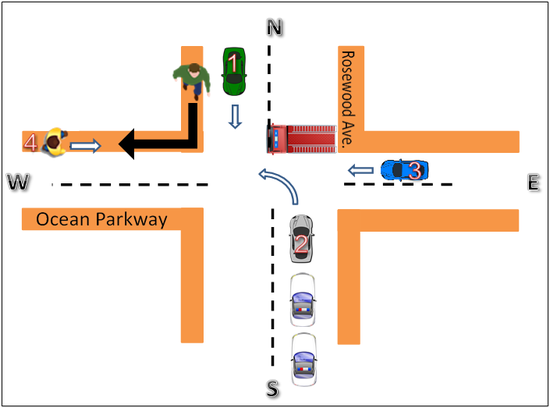Updated: February 25, 2025
The Traffic Enforcement Agent position is highly sought after in the NYPD. To get hired, you will first have to successfully pass a multiple-choice test with 9 sections.
Get an accurate simulation of the real exam with realistic questions and detailed explanations of all categories: Logical Reasoning, Reading Comprehension, Spatial Orientation and more. All practice tests are based on efficient use of insider information to help you pass the test.
The testing period for the NYC Traffic Enforcement Agent Exam starts Wednesday, April 9, 2025.
Practicing ahead of time allows you to become familiar with the test and build confidence.
Comprehensive practice for the Multiple-Choice test:
- 6 Deductive Reasoning practice tests
- 14 Inductive Reasoning practice tests
- 8 Information Ordering practice tests
- 8 Memorization practice tests and guide
- 13 Number Facility practice tests and guides
- 2 Problem Sensitivity practice tests
- 6 Spatial Orientation practice tests
- 11 Written Comprehension practice tests and guide
- 13 Written Expression practice tests
What Is the Traffic Enforcement Agent Exam?
To become an NYPD Traffic Enforcement Agent, you must take the Traffic Enforcement Agent (TEA) exam. When you apply to become an NYPD Traffic Enforcement Agent or any other position in the civil service field in New York City, then the application process will most likely be through the Department of Citywide Administrative Services (DCAS). The DCAS exam schedule is posted during the fiscal year and is updated on a monthly basis, in order to keep candidates up-to-date on any relevant changes.
Some of the duties of the job include issuing summonses to illegally parked vehicles, directing traffic at intersections, testifying at administrative hearing offices and court, and preparing required reports, as well as sometimes even being called upon to operate a motor vehicle.
Receiving a high score on the TEA exam increases your chances of becoming an agent. The starting salary for a Traffic Enforcement Agent is $29,217, which increases to $33,600 after two years. Other benefits of the job include paid vacation and sick leave, medical and dental plans, and a 401K.
The Traffic Enforcement Agent exam contains ten sections. The questions are in the multiple-choice format, and you need a score of 70% to pass. Becoming familiar with the test will help increase your score as well as your chances of becoming a Traffic Enforcement Agent.
Traffic Enforcement Agent Exam Sections
The exam measures the skills needed to be a successful Traffic Enforcement Agent. The exam is computerized and consists of multiple-choice questions. The following job-related qualities are measured:
- Deductive Reasoning – This section tests your ability to apply general rules to specific problems and to come up with logical answers.
- Inductive Reasoning – This section assesses your ability to combine together separate pieces of information or specific answers to problems, thus forming a general rule or conclusion.
- Information Ordering – The questions test your ability to comply with a rule or a set of rules and arrange things or actions in a certain order. For example, to perform mathematical or logical operations and to arrange numbers, letters, words, pictures, procedures, sentences, etc.
- Memorization -These questions evaluate your ability to observe and retain details.
- Number Facility – You are assessed on your ability to solve simple mathematical operations—adding, subtracting, multiplying, and dividing—as well as finding percentages and taking square roots.
- Problem Sensitivity – These questions test how well you identify a problem and its elements, and whether or not you can detect an error.
- Spatial Orientation – You are tested on your understanding of spatial relativity between an object and yourself.
- Written Comprehension – These questions test your ability to understand written sentences and paragraphs.
- Written Expression – You are tested on your ability to convey a clear written message in English.
- Memory questions – This section measures your memory for information expressed in words, numbers, pictures, and procedures.
Traffic Enforcement Exam Sample Questions
Written Comprehension Sample Question
Read the following paragraph and answer the question.
Although not acknowledged by any country as an official currency, Bitcoin is recognized and used as currency in e-trading worldwide, with a cap of 21 million Bitcoin units total. Authorities and financial experts alike have been dumbfounded by the arrival of this new element and are currently struggling to adjust their mindset and devise appropriate plans in dealing with Bitcoin. Bitcoin has been the cause of great concern on the part of banks as well, due to its potential status as a competing currency. All of the problems facing these different players in the economy are compounded by the potential of criminal elements dealing in e-trade, which has already been the cause of new legislation.
What is one of the aspects of Bitcoin that has been difficult for financial experts to deal with?
Problem Sensitivity Sample Question
Read the following rule and answer the question.
RULE
A correctional officer whose life is not being threatened may not shoot a violent inmate with a rifle or handgun unless it is a .22 caliber rimfire using rubber, sand, or rock-salt ammunition.
Which of the following is in violation of the rule?
Inductive Reasoning Sample Question





